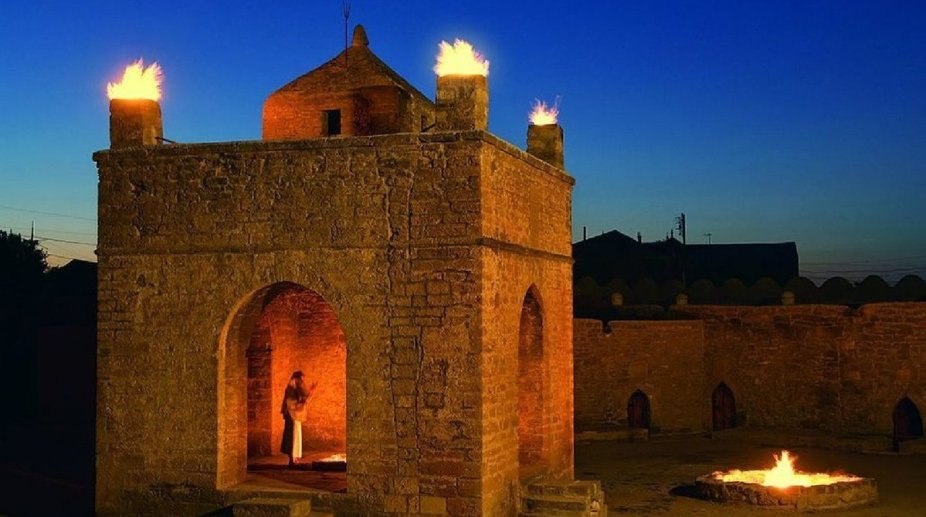China adds Pakistan, Belarus to build lunar base: Report
China has roped in Pakistan and Belarus to its moon programme that aims to construct a permanent lunar base in the 2030s.
What is the history of this temple? How did a fire temple with salutations to Hindu gods emerge in this predominantly Muslim Central Asian country located on the western side of the Caspian Sea?

(Photo: Twitter/@JAJafri)
On Friday, External Affairs Minister (EAM) Sushma Swaraj paid homage at the Fire Temple in Baku in Azerbaijan. The temple, known locally Ateshgah, is a medieval place of worship holy to Hindus, Sikhs and Zoroastrians.
Swaraj, who is on a three-day visit to the country, was seen standing with hands folded in prayer before an altar on which a fire was lit.
Advertisement

MEA spokesperson Raveesh Kumar said in a tweet that “the first line of the inscription at Ateshgah dating to 1745-46 venerates Lord Ganesha and second the holy fire”.
But what is the history of this temple? How did a fire temple with salutations to Hindu gods emerge in this predominantly Muslim Central Asian country located on the western side of the Caspian Sea?
So here are some quick facts:
1. The town where the temple is located is called Surakhani, which in Tat language means ‘hole with the fountain’. The Tat language is a form of Persian spoken by the Tat people around the Caspian Sea.
2. At the site, Ateshgah, there were several holes from which natural fires sprouted through. The word ‘Atesh’ means fire in Persian and ‘Gah’ means bed. Ateshgah once had a natural gas field underneath, which was the reason behind the natural fires.

3. That the site was considered holy has been attributed by many historians, including the 7th century Armenian geographer Anania Shirakatsi in his book Ashkharatsuyts.
4. Zoroastrians were the primary worshippers at the site. The region was at the time a part of the Persian Empire under Sasanian dynasty before its fall to Islamic invasion in 7th century. According to one source, the a mention of “Seven sacred fire holes” built by Shah Ardashir I (227-241) was made by Armenian scholars.
5. Though the region came under the influence of Islam, the Zoroastrians probably did not completely disappear. Noted 10th century geographer Abu Ishaq Ibrahim ibn Muhammad al-Farisi al-Istakhri (popularly known by his mononym Estakhri) wrote that ‘fire worshippers’ lived not far from Baku in a place what is now known as Ateshgah.
6. But it was in the 18th century that Hindus, Sikhs and Zoroastrians started arriving in the area in larger numbers.

7. The Hindus arrived because of trade. The region fell along one of the many prominent trade routes connecting Indian sub-continent to the West through Central Asia.
8. Construction of the temple as it stands today began after the Hindus arrived, which is sometime in the late 17th or early 18th century. European travellers and historians documented the presence of Hindus, Sikhs and ‘Parsis’ (Zoroastrians) from around 1683 to 1880.
9. There are 14 Sanskrit, two Punjabi and one Persian inscription in the Ateshgah. The only Persian inscription has grammatical errors.

10. Of the two Sanskrit inscriptions, one mentions Lord Ganesha and Jwala ji while the other is an invocation to Lord Shiva. The inscription mentioning Lord Shiva has motifs of Sun and swastika.
11. According to Abraham Valentine Williams Jackson’s ‘From Constantinople to the home of Omar Khayyam’, the inscriptions were carved between 1668 and 1816 AD.
12. Parsi priests were sent to the region from India till 1880. In 1925, a Parsi priest named Dr. Sir Jivanji Jamshedji Modi visited Ateshgah and concluded that the temple was Hindu in character yet later evidences did not rule out the place’s Zoroastrian origin.
13. The flame used to burn naturally till 1969 till rampant gas extraction by the Soviets emptied the reserves.
14. The fuel for the fire that now burns is fed from a gas pipeline coming all the way from Baku.
15. Ateshgah was listed as a World Heritage Site by UNESCO in 1998.
Advertisement